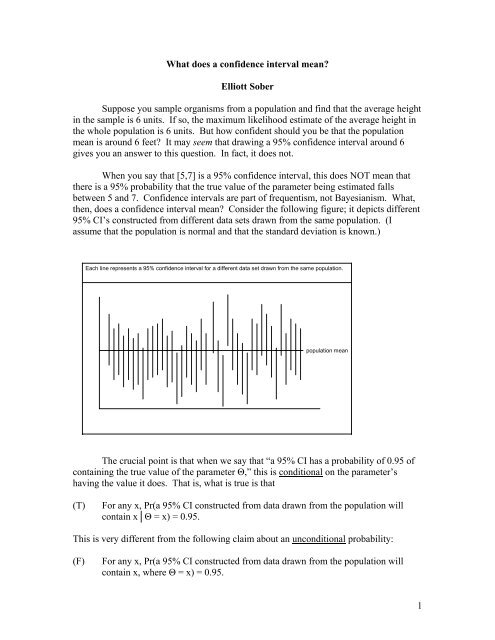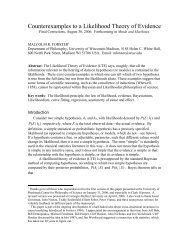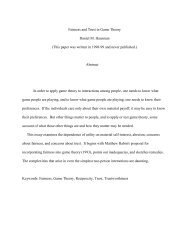1 What does a confidence interval mean? Elliott Sober Suppose you ...
1 What does a confidence interval mean? Elliott Sober Suppose you ...
1 What does a confidence interval mean? Elliott Sober Suppose you ...
Create successful ePaper yourself
Turn your PDF publications into a flip-book with our unique Google optimized e-Paper software.
<strong>What</strong> <strong>does</strong> a <strong>confidence</strong> <strong>interval</strong> <strong>mean</strong>?<br />
<strong>Elliott</strong> <strong>Sober</strong><br />
<strong>Suppose</strong> <strong>you</strong> sample organisms from a population and find that the average height<br />
in the sample is 6 units. If so, the maximum likelihood estimate of the average height in<br />
the whole population is 6 units. But how confident should <strong>you</strong> be that the population<br />
<strong>mean</strong> is around 6 feet? It may seem that drawing a 95% <strong>confidence</strong> <strong>interval</strong> around 6<br />
gives <strong>you</strong> an answer to this question. In fact, it <strong>does</strong> not.<br />
When <strong>you</strong> say that [5,7] is a 95% <strong>confidence</strong> <strong>interval</strong>, this <strong>does</strong> NOT <strong>mean</strong> that<br />
there is a 95% probability that the true value of the parameter being estimated falls<br />
between 5 and 7. Confidence <strong>interval</strong>s are part of frequentism, not Bayesianism. <strong>What</strong>,<br />
then, <strong>does</strong> a <strong>confidence</strong> <strong>interval</strong> <strong>mean</strong>? Consider the following figure; it depicts different<br />
95% CI’s constructed from different data sets drawn from the same population. (I<br />
assume that the population is normal and that the standard deviation is known.)<br />
Each line represents a 95% <strong>confidence</strong> <strong>interval</strong> for a different data set drawn from the same population.<br />
population <strong>mean</strong><br />
The crucial point is that when we say that “a 95% CI has a probability of 0.95 of<br />
containing the true value of the parameter Θ,” this is conditional on the parameter’s<br />
having the value it <strong>does</strong>. That is, what is true is that<br />
(T) For any x, Pr(a 95% CI constructed from data drawn from the population will<br />
contain x│Θ = x) = 0.95.<br />
This is very different from the following claim about an unconditional probability:<br />
(F) For any x, Pr(a 95% CI constructed from data drawn from the population will<br />
contain x, where Θ = x) = 0.95.<br />
1
The difference between the true principle (T) and the false principle (F) is the same as the<br />
difference between Pr(X│Y) and Pr(X&Y). The sentence quoted at the start of this<br />
paragraph is false or misleading as stated. Notice that the figure could not be<br />
drawn without first deciding what the true value of Θ, the population <strong>mean</strong>, is.<br />
The probability of 0.95 in (T) indicates that <strong>you</strong> should expect that about 95% of<br />
the CI’s constructed from different data sets will include the population <strong>mean</strong> and about<br />
5% will fail to do so. The figure shows the CI’s drawn for 40 data sets. There are 4<br />
failures here, which is a few more than the expected value (2), but of course that sort of<br />
thing can happen.<br />
One further comment: (T) talks about the probability that “a” 95% CI will<br />
contain the number x. Why the indefinite article? Two points are relevant. First, there<br />
are many 95% CI’s that might be constructed from a single data set. Second, the claim is<br />
not that at least one of those 95% CI’s will have a probability of 0.95 of containing the<br />
number x. Rather, (T) should be understood to assert that each of those 95% CI’s has a<br />
probability of 0.95 of containing the number x. To simplify our discussion, I’m going to<br />
assume that there is just one 95% CI that an investigator will construct from a given data<br />
set. This involves rewriting (T), slightly, as follows:<br />
(T*) For any x, Pr(the 95% CI constructed from data drawn from the population will<br />
contain x│Θ = x) = 0.95.<br />
* * *<br />
The true principle (T*) is a universal generalization, and the principle from<br />
deductive logic called universal instantiation (from “all x’s are F,” infer that the<br />
individual i is F) applies to it. That is, it follows from (T*) that<br />
And that<br />
Pr(the 95% CI constructed from data drawn from the population will contain<br />
14│Θ = 14) = 0.95.<br />
Pr(the 95% CI constructed from data drawn from the population will contain<br />
6│Θ = 6) = 0.95.<br />
Now suppose <strong>you</strong>r data lead <strong>you</strong> to construct the 95% CI whose bounds are [5,7]. Does<br />
it follow from the above two displayed statements that<br />
and that<br />
Pr([5,7] contains 14│Θ = 14) = 0.95.<br />
Pr([5,7] contains 6│Θ = 6) = 0.95?<br />
2
These had better not follow, since these last two probability statements are false; the<br />
correct value for the first is 0, while the correct value for the second is unity.<br />
240):<br />
In fact, the following argument is fallacious (see Howson and Urbach, pp. 239-<br />
Pr(the 95% CI constructed from the data contains 6│Θ = 6) = 0.95.<br />
[5,7] = the 95% CI constructed from the data.<br />
-----------------------------<br />
Pr([5,7] contains 6│Θ = 6) = 0.95.<br />
The logical flaw in this argument has nothing special to do with CI’s. The same mistake<br />
occurs in the following argument about the throwing of a fair die:<br />
Pr(the result of the next throw is an even number│the die is thrown) = ½ .<br />
4 = the result of the next throw.<br />
---------------<br />
Pr(4 is an even number│the die is thrown) = ½ .<br />
The premises are true but the conclusion is false; the proposition that 4 is an even number<br />
has a probability of unity, no matter what <strong>you</strong> conditionalize on. The general lesson here<br />
is that probability statements contain “opaque contexts” (a term from the philosophy of<br />
language); this <strong>mean</strong>s that substituting co-referring terms is not logically valid. Here are<br />
two examples from outside probability:<br />
It’s a contingent fact that the number of planets > 7.<br />
The number of planets = 9.<br />
-------------<br />
It’s a contingent fact that 9>7.<br />
Lois Lane believes that Superman can fly.<br />
Superman = Clark Kent.<br />
-----------------------<br />
Lois Lane believes that Clark Kent can fly.<br />
Both these arguments are fallacious; modal statements (“it’s contingent that p,” “it’s<br />
necessary that q”) contain opaque contexts, and so do statements that involve<br />
propositional attitudes about what agents believe and desire. ∗ Probability is another<br />
modality, so it is no surprise that the probability operator Pr(-│-) contains opaque<br />
contexts. Watch out for substitutions!<br />
* * *<br />
∗ As an exercise, show that “S desires ____” contains an opaque context.<br />
3
Confidence <strong>interval</strong>s are regarded as <strong>interval</strong> estimates. For example, the<br />
statement that [5,7] is a 95% CI is usually taken to <strong>mean</strong> that [5,7] is a “good” <strong>interval</strong><br />
estimate of Θ. This might lead <strong>you</strong> to think that there is a probability statement that has<br />
the proposition “Θ falls in the <strong>interval</strong> [5,7]” in it somewhere, and which assigns to the<br />
probability in question a value of 0.95. Let us consider some options concerning what<br />
this probability statement might be:<br />
(1) Pr(Θ is between 5 and 7│the sample <strong>mean</strong> is between 5 and 7) = 0.95.<br />
(2) Pr(the sample <strong>mean</strong> is between 5 and 7│Θ is between 5 and 7) = 0.95.<br />
(3) Pr(the sample <strong>mean</strong> is 6│Θ is between 5 and 7) = 0.95.<br />
(4) Pr(Θ is between 5 and 7│Θ = 6) = 0.95.<br />
None of these statements correctly describes what it <strong>mean</strong>s for [5,7] to be a 95% CI for<br />
Θ. Statement (1) assigns a posterior probability to the <strong>interval</strong> estimate of Θ. But<br />
<strong>confidence</strong> <strong>interval</strong>s are not Bayesian and principle (T) <strong>does</strong>n’t assign a posterior<br />
probability to any <strong>interval</strong> estimate. Statement (2) improves matters; at least the claim<br />
about the unknown parameter Θ is on the right side of the conditional probability sign.<br />
But (2) isn’t what it <strong>mean</strong>s to say that [5,7] is a 95% CI. Notice that the hypothesis<br />
described in (2) – that Θ is between 5 and 7 -- is composite; there are many ways that Θ<br />
can be between 5 and 7. The same is true of statement (3); however, the probability of<br />
obtaining a sample whose <strong>mean</strong> value is exactly 6 is zero if the population is normal and<br />
has a nonzero standard deviation. So (3) is false. And so is (4); as already noted, the true<br />
value of the conditional probability it describes is unity, not 0.95.<br />
Proposition (T) describes what it <strong>mean</strong>s to construct a 95% CI. It says that if <strong>you</strong><br />
apply this procedure of construction to different data sets drawn from the same<br />
population (as the figure depicts), <strong>you</strong> can expect to construct <strong>interval</strong>s that include the<br />
true population <strong>mean</strong> about 95% of the time. When <strong>you</strong> use this procedure on the single<br />
data set at hand, <strong>you</strong>’re using a procedure that has a probability of 95% of producing an<br />
<strong>interval</strong> that includes the true value. But this statement about the procedure <strong>you</strong>’re using<br />
<strong>does</strong>n’t allow <strong>you</strong> to make a probability statement about the <strong>confidence</strong> <strong>interval</strong> <strong>you</strong><br />
construct. The <strong>interval</strong> [5,7] either includes Θ, or it <strong>does</strong>n’t. All that can be said of the<br />
<strong>interval</strong> [5,7] is that it was constructed by a procedure that is described by (T). The<br />
probability claim can be made about the procedure of constructing a <strong>confidence</strong> <strong>interval</strong>,<br />
not about the <strong>confidence</strong> <strong>interval</strong> <strong>you</strong> construct.<br />
4




